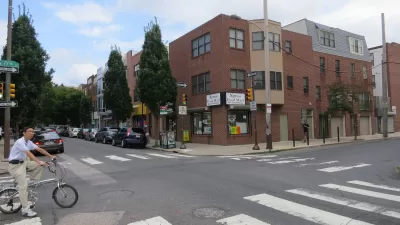A new study by researchers at the Urban Institute finds new evidence that upzoning produces housing supply and reduces costs, while downzoning does the opposite.

A study published recently in the journal Urban Studies has produced “the first cross-city panel dataset of land-use reforms” to quantify the impact on housing supply and rents.
The study is behind a paywall at the journal, but from the study’s abstract, we can see that the study used machine-learning algorithms to search U.S. newspaper articles between 2000 and 2019, merging the data with U.S. Postal Service and Census data.
“We find that reforms that loosen restrictions are associated with a statistically significant 0.8% increase in housing supply within three to nine years of reform passage, accounting for new and existing stock,” according to the abstract.
The Urban Institute also wrote up the study for an article on their own website, providing further insight into the study’s methodology and findings. For example, the resulting increase in housing supply is greater at the higher end of the market, and the research finds “no statistically significant evidence that additional lower-cost units became available or became less expensive in the years following reforms.”
Still, the benefits still manage to spread to other parts of the market, according to the study: “impacts are positive across the affordability spectrum and we cannot rule out that impacts are equivalent across different income segments.”
The study also found the converse to be true: “reforms that increase land-use restrictions and lower allowed densities are associated with increased median rents and a reduction in units affordable to middle-income renters.”
The new research is the latest in an ongoing debate, central to the political debate happening between pro-development political forces (i.e., YIMBYs) and those opposing developments, including both anti-displacement and neighborhood character protection groups.
FULL STORY: Land-Use Reforms and Housing Costs

Florida Considers Legalizing ADUs
Current state law allows — but doesn’t require — cities to permit accessory dwelling units in single-family residential neighborhoods.

Manufactured Crisis: Losing the Nation’s Largest Source of Unsubsidized Affordable Housing
Manufactured housing communities have long been an affordable housing option for millions of people living in the U.S., but that affordability is disappearing rapidly. How did we get here?

Research Shows More Roads = More Driving
A national study shows, once again, that increasing road supply induces additional vehicle travel, particularly over the long run.

EV Chargers Now Outnumber Gas Pumps by Nearly 50% in California
Fast chargers still lag behind amidst rapid growth.

Affordable Housing Renovations Halt Mid-Air Amidst DOGE Clawbacks
HUD may rescind over a billion dollars earmarked for green building upgrades.

Has Anyone at USDOT Read Donald Shoup?
USDOT employees, who are required to go back to the office, will receive free parking at the agency’s D.C. offices — flying in the face of a growing research body that calls for pricing parking at its real value.
Urban Design for Planners 1: Software Tools
This six-course series explores essential urban design concepts using open source software and equips planners with the tools they need to participate fully in the urban design process.
Planning for Universal Design
Learn the tools for implementing Universal Design in planning regulations.
City of Moreno Valley
Institute for Housing and Urban Development Studies (IHS)
City of Grandview
Harvard GSD Executive Education
City of Piedmont, CA
NYU Wagner Graduate School of Public Service
City of Cambridge, Maryland





























